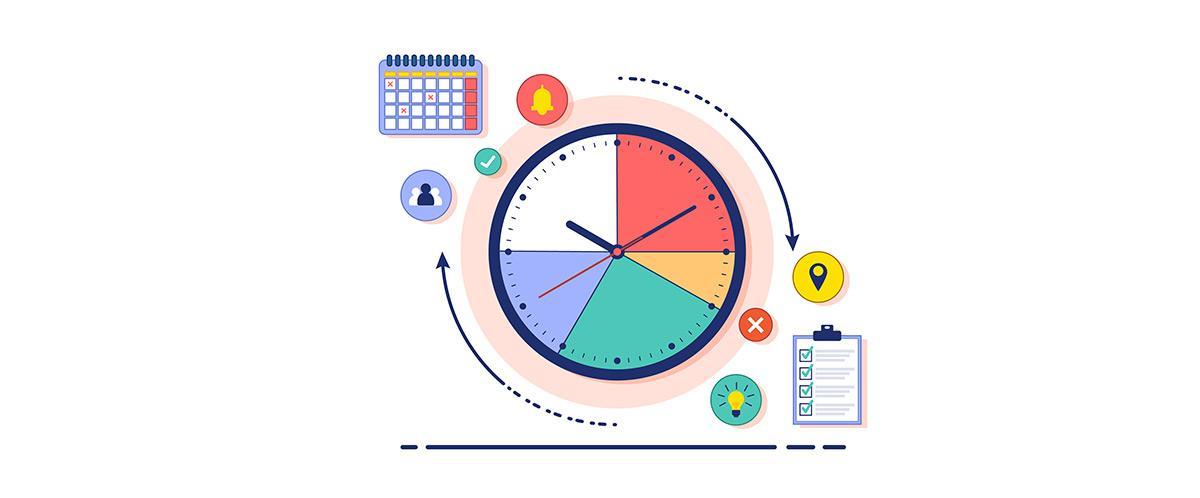In-class Time management strategies allow you to plan out your time so that you can get your essential tasks done and achieve learning objectives. In this module, we’ll explore the importance of various time management techniques and how to allot the appropriate time for required tasks. Effective time management in the classroom is critical not only to help keep you on schedule, but it is also essential in keeping your students interested and motivated.
Time management in the classroom:
Practicing effective time management in the classroom is a skill that you will develop over time at the beginning of your career. It must be understood that effective use of time in the classroom directly affects the quality of teaching. Not every class lesson is the same, teaching different topics or subjects requires the teacher to estimate the optimum distribution of in-class activities.
The lesson time might be divided into the following main sections/phases:
-
- Introducing the concept.
- Explain the concept in detail.
- provide examples or applications to help solidify ideas.
- Interacting through exercises to make sure that the main learning objectives have been met.
Each phase must be allotted the appropriate time in order to fully benefit from the lesson and make sure the teacher does not run out of time.

The following points must be taken into consideration for the success of effective time management in the classroom:
- The approach to teaching a topic to a class at the elementary level is completely different from the preparatory stage and completely different for the higher-level classrooms. A teacher should try their best to tailor their teaching techniques to suit the class level they are educating.
- To create the optimum teaching environment, teachers must allot time to tend to individual students. Since there will inevitably be differences in the way different students understand a topic, the teacher must understand that it might take a little bit more time to make sure no student is left behind.
- Teachers can let their students in on their planned usage of class time beforehand so that the students understand the structure of the upcoming lesson. For example, the teacher can write or announce that they will use the next 20 minutes to explain a topic. Afterword’s, the students will be given 10 minutes to fill out a worksheet and 5 minutes to share their answers.
- If the lesson feels monotone and too long, students will lose interest in the topic. That is why it is important to consider switching up the in-class activities regularly without spending too much time on one task and thus losing the students’ attention.

Effective lesson planning
Preplanning lessons strategically is the best way to ensure that each lesson has the potency required to achieve long-term teaching goals. Structuring each class session by allotting appropriate times for in-class activity will help teachers feel prepared for each lesson and avoid wasting time. The best way to start your planning process is to set clear long- and short-term goals for the class. Examples of those might be to assure students understand the different chemical reactions, in order to successfully pass the practical/lab assessment at the end of the year. The teacher should then break down those goals into smaller manageable tasks which will then be distributed over several class sessions. Afterwards, the teacher will look at every session individually and plan the most effective structure for that day in class.
Key consideration to planning lessons:
- The teacher must take into consideration the learning objectives of the curriculum required by the institute/school.
- The integration of continuous assessment and feedback is paramount to ensure the lesson planning is effective.
- Lesson plans must take into consideration the diverse learning needs of the students. Some students might need more time to grasp a concept, which might take more time.
- There must be a natural and logical progression of topics and methods to optimize learning. The teacher should figure out the best sequence of delivering new concepts to the students.
- Documenting lesson plans in an organized manner will ensure that the teacher will stay put together and prepared. The use of technology to do so is the most effective method since teachers can now create a digital office that they can access at their own convenience.

Problems related to time management in the classroom:
Here are three major problems with time management in the classroom and how to handle them.
The first problem: Unclear Procedures
Not setting clear policies and not announcing procedures that facilitate the work and interaction of students. From the start of academic year, the teacher must define policies for their class, such as leaving questions till a specific time allocated to asking questions, to avoid wasting time. The teacher must confirm the procedures that the class will follow. For example, it is important that everyone understands and students know when to expect assignments and activities, what to do while attending the class, and how to find course information. Immediately establishing clear procedures can prevent many time management issues, allowing instructional time to be used for learning!
The second problem: Difficulty balancing individual attention
As previously mentioned, teachers must allot time for providing individual attention to students that might struggle grasping specific topics. A problem that might arise is spending too much time on struggling students and losing time that could have been used to move the lesson forward. Teachers must find a balance in attending to individual needs but also understand that they have a lesson to complete for the whole class. An additional solution is to provide office hours for struggling students to present their questions and concerns and thus not take away from classroom time.
The third problem: Inefficient Transitions
Moving from one activity to another can consume valuable time in the classroom. Unclear transitions might get students confused about the next activity, resulting in a complete loss of classroom management. Even if the teacher has designed fun and effective activities for the lesson unless the transition to the next activity is clear and understandable, and unless you specify a mechanism for moving between the two activities, the random transition may lead to chaos. Teachers must stay on top of the classroom and introduce each topic or activity clearly.

